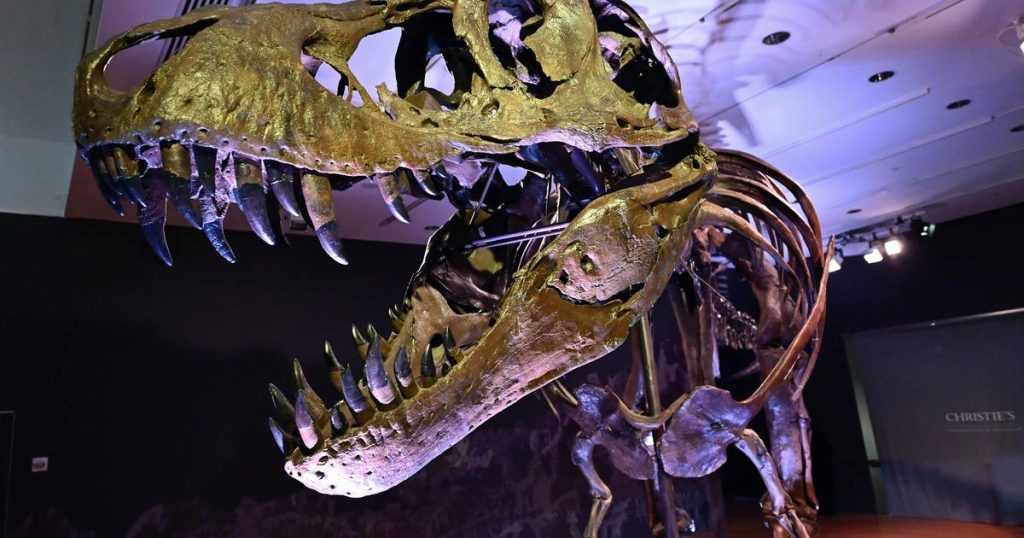Tyrannosaurus was the ultimate and most famous predator among all types of dinosaurs. The dinosaur has appeared on the silver screen several times. Researchers now claim that not only do T-rex exist, but that three different species of Tyrannosaurs once roamed the Earth.
GVBR
Last updated:
05-03-22, 15:30
source:
The Guardian, VRT NWS, De Morgen, Reuters
Tyrannosaurus rex, a loosely translated triannic lizard king, was first described in 1905 and was the only species in the genus Tyranossaurus throughout that time. But a group of three researchers, led by American paleontologist Gregory Ball, now suggest that there are two more species in this genus: ‘Tyrannosaurus imperator’, loosely translated tyrannical emperor lizard, and ‘Tyrannosaurus regina’, or tyrannical queen of lizards. The team of paleontologists examined and analyzed the bones and teeth of 37 Tyrannosaurus fossils, noting many differences.
“After more than a century of placing all specimens in one species, without examining the matter closely, the first and only analysis shows that the variance in Tyrannosaurus is greater than the dinosaur standard, and that it is time-broken in such a way that this indicates that Darwinian breeding occurred from one species to two species. Two new ones, before the eventual extinction of the dinosaurs leads to further evolution.”
A sister species and an ancestor
The researchers now state that the differences between the thigh bones and teeth do not refer to a different species of dinosaur, but rather to a different species within the genus Tyrannosaurus. That’s why the team suggested “Tyrannosaurus imperator” and “Tyrannosaurus regina.”
According to researchers, the emperor, or emperor, is said to be the oldest and that the species lived a long time ago. The animal had relatively strong thighs and four small incisors in the lower jaw. Rex and Regina had only two interrupters. They could have been the smaller types of Emperor. Regina had slimmer thighs and, according to the researchers, was a lighter build. In other words, the T-Rex had an ancestor and a sister.
However, Ball and his team acknowledge that it is also possible that the differences observed were due to individual differences in the specific fossils. Although these would be very extreme, the researchers say. Paul compares the differences observed with the differences between a tiger and a lion. “Lions and tigers belong to the same genus as panther, but they are recognized as separate species because the differences are large enough,” Ball said.
Watch also: T-rex runs slower than humans
Other paleontologists are not convinced
According to other paleontologists, the new study by Paul and his team may not be entirely correct. They argue that the researchers drew conclusions too quickly. “I understand the temptation to divide the T-Rex into different species, because there is already some difference in the bones that we know of. But in the end, as far as I’m concerned, that difference is very small. Stephen Brusatte, a paleontologist at the University of Edinburgh, told the British weekly New Scientist this week. Until I see stronger evidence, this will still be just a T-Rex to me.
And Thomas Carr, a paleontologist at Carthage College, believes the research is not entirely correct. He conducted a study in 2020 on possible variants in the genus Tyrannosaurus, but found no evidence. “I think they only see what they want to see,” he says in the same magazine. “If their types were valid, they would have to be defined by more than just two attributes: almost every detail would have to be different.”
What is a dinosaur?
The dinosaur lived during the late Cretaceous, the end of the age of dinosaurs, in western what is now North America. About 66 million years ago, all dinosaurs, except for birds, died due to the impact of an asteroid on Earth.
With a giant head, fearsome teeth, and tremendous bite force, the T-rex was the ultimate predator of all dinosaurs. The T-rex also had strong legs, but small arms hanging off the upper body.
The largest dinosaur we know so far is Sue. It is on display at the Fields Museum in Chicago. Sue is well preserved and is also almost complete, which is rare. According to this new study, Sue wouldn’t be a Tyrannosaurus Rex, but it wouldn’t be a Tyrannosaurus imperator.
Watch also:
Read also:
Unlimited free access to Showbytes? And that can!
Sign in or create an account and never miss a thing from the stars.

“Total coffee specialist. Hardcore reader. Incurable music scholar. Web guru. Freelance troublemaker. Problem solver. Travel trailblazer.”







More Stories
GALA lacks a chapter on e-health
Weird beer can taste really good.
Planets contain much more water than previously thought